Types of Card Sleeves Explained: Which Protection Style Will Save Your Collection's Value?
- Dr. Mardis

- Oct 13
- 3 min read
Card sleeves prevent damage. Damage reduces value. The sleeve type determines protection level.
Penny Sleeves: Basic Function
Penny sleeves cost approximately one cent each. Made from thin polypropylene. Standard dimensions: 2 5/8 x 3 5/8 inches.
Protection level: minimal. Blocks dust and light scratches. Does not prevent bending or edge wear. Suitable for bulk storage of low-value cards.
Material thickness: 50-60 microns. Cards slide easily. Fit is loose.

Inner Sleeves: Perfect Fit Technology
Perfect fit sleeves seal card edges completely. No air gaps. Prevents moisture infiltration.
Installation process: card enters from top opening. Sleeve seals around perimeter. Often used with outer sleeve for double protection.
Material: clear polypropylene. Thickness: 40-50 microns. Tight fit prevents movement inside sleeve.
Standard Premium Sleeves: Industry Baseline
Premium sleeves use thicker polypropylene construction. Standard gaming sleeve dimensions: 63.5 x 88mm.
Protection improvements over penny sleeves: increased tear resistance, better corner protection, reduced scratching during handling.
Material thickness: 80-100 microns. Higher durability rating. Cards maintain position during shuffling.
Matte vs Glossy Surface Finishes
Matte finish reduces glare. Provides texture for grip during handling. Scratches become less visible over time.
Glossy finish maximizes card visibility. Shows artwork clearly. Scratches appear more prominently. Surface reflects light.
Tactile difference: matte sleeves stack better, glossy sleeves slide against each other.

Thick Sleeves: Maximum Protection
Thick sleeves measure 100+ microns in material thickness. Designed for high-value cards requiring maximum protection.
Construction features: reinforced seams, precision-cut openings, enhanced corner protection. Cost per sleeve increases proportionally with thickness.
Drawback: increased bulk during storage. Storage boxes accommodate fewer sleeved cards.
Material Composition Standards
Acid-free polypropylene prevents long-term card degradation. PVC materials contain plasticizers that damage cards over time.
Chemical requirements for preservation-grade sleeves:
No PVC content
Acid-free materials only
Food-grade safety standards
UV-resistant compounds
Non-compliant materials cause yellowing, sticking, and permanent damage.
Sizing Specifications
Card games require specific sleeve dimensions. Incorrect sizing reduces protection effectiveness.
Standard USA game sleeves: 56 x 87mm Euro game sleeves: 59 x 92mm Trading card sleeves: 63.5 x 88mm Mini card sleeves: 41 x 63mm
Oversized sleeves allow card movement. Undersized sleeves stress card edges during insertion.

Resealable Technology
Dragon Shield manufactures sleeves with four-edge sealing capability. Card inserts through opening. Flap insertion seals all edges completely.
Function: creates hermetic barrier around card. Prevents moisture, dust, and contaminant entry. Higher cost than standard sleeves.
Compatible with double-sleeving methods. Functions as inner sleeve with outer sleeve protection.
Cost Analysis: Protection Return
Penny sleeves: $0.01 per card protected. Suitable for cards valued under $5.
Premium sleeves: $0.05-0.15 per card protected. Recommended for cards valued $5-50.
Thick premium sleeves: $0.20-0.50 per card protected. Required for cards valued over $50.
Double-sleeving cost: combines inner and outer sleeve pricing. Increases protection exponentially.
Common Protection Failures
Poor fit causes edge damage during insertion. Oversized sleeves permit card shifting and corner impact.
Chemical incompatibility degrades cards over months or years. PVC sleeves release plasticizers that bond permanently to card surfaces.
Inadequate thickness allows bending forces to transfer through sleeve material to card.
Low-quality manufacturing creates rough internal surfaces that scratch card faces during handling.

Use Case Applications
Bulk inventory storage: Penny sleeves for cards under $5 value. Storage efficiency priority over maximum protection.
Active gameplay decks: Premium matte sleeves for frequent handling. Balance between protection and tactile performance.
High-value collection pieces: Double-sleeving with perfect fit inner and premium outer sleeves. Maximum protection investment.
Display collections: Glossy premium sleeves for visual presentation. Minimal handling expected.
Storage Environment Factors
Sleeve material interacts with storage conditions. High humidity environments require better barrier protection.
Temperature fluctuations stress sleeve materials. Quality sleeves maintain flexibility across temperature ranges.
Light exposure degrades both cards and sleeves over time. UV-resistant sleeve materials provide extended protection periods.
Professional Collection Standards
Sports card grading companies accept certain sleeve types for submission protection. PSA and BGS specify acceptable materials for transport sleeves.
Insurance valuations consider protection methods. Documented protection protocols support claim valuations.
Auction houses note protection quality in lot descriptions. Professional storage methods influence buyer confidence.

Protection Hierarchy
Maximum protection: Double-sleeving with perfect fit inner sleeve and premium thick outer sleeve.
Standard protection: Single premium sleeve with appropriate sizing and material specifications.
Minimal protection: Penny sleeve for temporary protection during transport or basic storage.
No protection: Direct storage results in measurable value degradation over time.
Material Degradation Timeline
Quality sleeves maintain protection properties for 5-10 years under normal storage conditions.
PVC sleeves begin degradation within 1-2 years. Plasticizer migration becomes visible on card surfaces.
Environmental stress accelerates degradation. High temperature, humidity, and light exposure reduce protection lifespan.
Quality Assessment Methods
Visual inspection reveals manufacturing defects. Rough edges, uneven thickness, and poor seam construction indicate quality issues.
Flexibility testing determines material durability. Quality sleeves bend without cracking or permanent deformation.
Chemical smell indicates material composition problems. Food-grade sleeves produce no odor.
The protection level you choose determines your collection's long-term value retention. Choose accordingly.
Comments